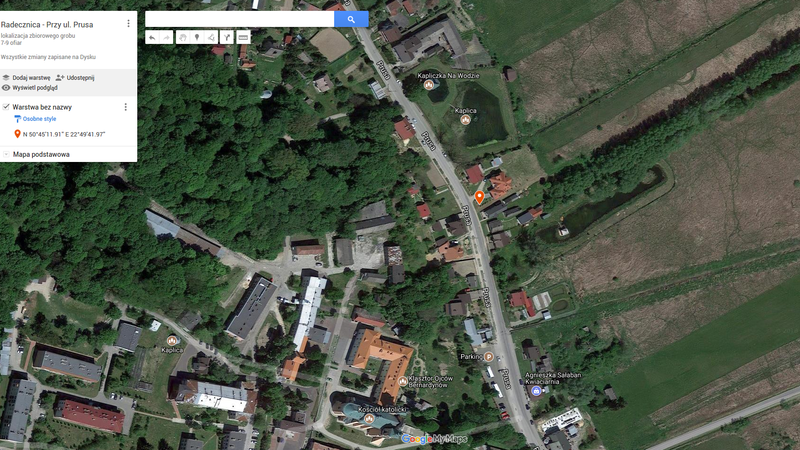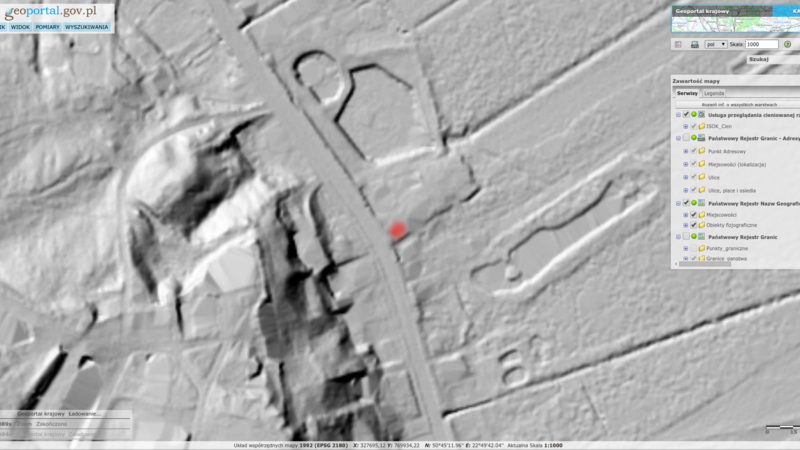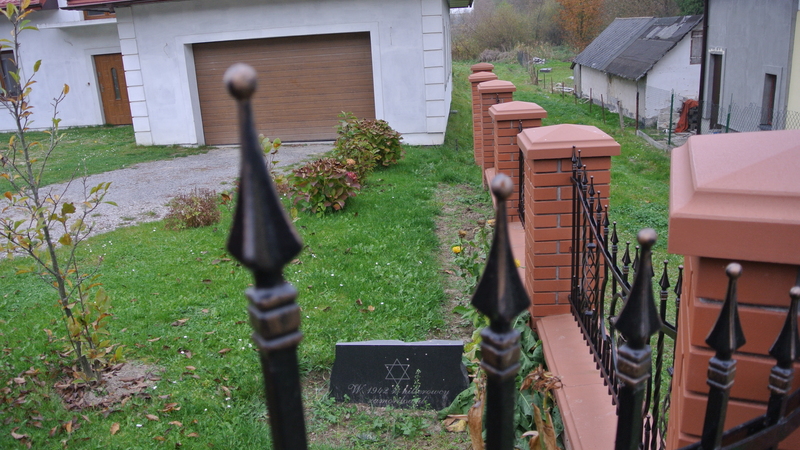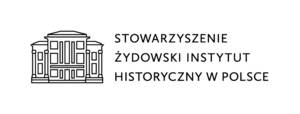Radecznica – at Prus Street
Borough of Radecznica, Zamość District, Lubelskie VoivodshipType of place
A grave of 7 people at Prus Street murdered in July 1942 (on Stanisław Zybała’s map: a grave near the grotto of St. Francis).Information about the crime
The existence of unmarked Jewish graves of the Holocaust victims in the village of Radecznica was brought to our attention by a letter from Stanisław Zybała (a resident of the village, born in 1930) written on 6 October 2010 to the Jewish Religious Community in Lublin and passed over to the Rabbinic Commission for Cemeteries. There was a map drawn by Mr Zybała and attached to the letter which indicated the sites of burial of the murdered Jews. In his letter and during two meetings with us Mr Zybała described the following events:
“The first pogrom. Here [in the letter] I didn’t include it because Wulwa Mantel was killed here. Here, as it was common in 1939 between the Bolsheviks and the Nazis, was a kind of anarchy. And there were pogroms, in every town and village. The pogrom in Żółkiewka I described in detail but there was one in Radecznica as well. […] As it’s customary in such anarchy, some folks went through Zaporze and Radecznica shooting at houses. They were looking for the keys to the church in Jewish homes. It was just propaganda. And one of them was taken. I remember when I was told about it, I was 9 years old then. The taken man was called Wulwa.” (Radecznica, 28 July 2013.)
A grave of 7 people at Prus Street murdered in July 1942 (on Stanisław Zybała’s map: a grave near the grotto of St. Francis):
“It was in July 1942. I was walking back with my mother from mushroom picking. Father Wajstuch was killed here with his son-in-law who came from Turobin and his daughter Sura or Sara. […] [The grave] was damaged when they were running pipes for the sewage system. They stumbled upon this grave from 1942 of seven or nine people. Moszek Wajstuch, his heavily pregnant daughter Sura and her husband – Wajstuch’s son-in-law and four more men who lived where Wulwa used to live. It was next to the wall of this hut. The victims were buried there. And now it has been found.” (Radecznica, 28 July 2013.)
According to Stanisław Zybała, Zelik, Menasze, Kalman and Sura were killed at that time.
The place where bodies of the murdered people were first buried was pointed out to us by Marianna, Stanisław’s wife: “It was his [Rubin Weistuch’s – the only member of this family who wasn’t killed then, who survived the war, settled in Israel and went back to Radecznica several times to meet with Stanisław and Marianna] sister, beautiful Sura – all the neighbours were saying what a beautiful girl she was. I mean, she was already married. She was pregnant with her first child. The military policeman told her to move away because they were killing men only. After the massacre women escaped to the forest. They were running away lamenting that the terrible crime had been committed. But Sura was heavily pregnant and she threw herself at her husband to hug him and when they shot [from an automatic gun] she must have been shot too. She must have been shot in the stomach because her baby was still moving for a moment. Neighbours who saw it told me that. I can’t talk about it…” (Radecznica, 15 October 2013.)
In August 2012 during works at Prus Street in Radecznica fragments of human bones were found. The remains were sent to the Institute of Anatomical Pathology of the Voivodship Hospital in Zamość. In the autumn of 2013 they were collected by a representative of the Rabbinic Commission and buried on the Jewish cemetery in Szczebrzeszyn. In the course of proceedings it was established that the discovered remains “probably belonged to people of Jewish nationality – members of the Weistuch family (including Mosze Weistuch and his daughter Sara) and the Mantel family who were shot to death by officers of the German state in July 1942.”
IDENTIFICATION OF THE GRAVE BASED ON NON INVASIVE RESEARCH
On the 15th of October 2014, a local vision of the place of the mass grave indicated by the witness was carried out (GPS: N50°45′11.91’E22°49’41.97′). Human remains were found in this location and buried by representatives of the Rabbinical Commission at the Jewish cemetery in Szczebrzeszyn.
No GPR surveys were conducted.
The LIDAR survey is not helpful in this case.
The aerial photography query for this area wasn’t ordered.
 Radecznica - Przy ul.Prusa fotografia satelitarna 3 lokalizacji Przy ul.Prusa
Radecznica - Przy ul.Prusa fotografia satelitarna 3 lokalizacji Przy ul.Prusa Radecznica - Przy ul.Prusa lidar 1g ul.prusa
Radecznica - Przy ul.Prusa lidar 1g ul.prusa Radecznica - Przy ul.Prusa fotografia 4 lokalizacja ul.prusa
Radecznica - Przy ul.Prusa fotografia 4 lokalizacja ul.prusaTranskrypcje
Contact and cooperation
We are still looking for information on the identity of the victims and the location of Jewish graves in Radecznica. If you know something more, write to us at the following address: fundacjazapomniane@gmail.com.
Bibliography
Recording of the Zapomniane Foundation (audio file), name: Stanisław Zybała [eyewitness], b. 1930, subject and keywords: Jewish graves in Radecznica, interviewed by Agnieszka Nieradko, Radecznica, 28 July 2013.
Zybała M., Zybała Rozwar S., Tak Cię widzę Radecznico, Radecznica 1998-2000.
Grzeszkiewicz Smoter R., Zybała Rozwar S., Ludność żydowska w gminie Radecznica, Szczebrzeszyn 2015.
GK 163/19, p. 1299, Questionnaire of places and facts of German crimes carried out by town courts. Lublin province. Questionnaire. Executions. Graves Lubelskie province; vol. 8, p. 1299.
IPN BU 2448/607, 608, Questionnaires of the Chief Commission for the Examination of German Crimes in Poland, Zamość district.
IPN BU 2448/608 from the files of the group Questionnaires of the Chief Commission for the Examination of German Crimes in Poland.
IPN Lu 1/13/78 cards 140, 140v, 141, 141v, the former Regional Commission for the Examination of German Crimes in Lublin, Questionnaire of places and facts of German crimes, Zamość district.
The register of sites and crimes committed by the Germans in Poland between 1939 and 1945, Warsaw 1994, Zamojskie province, p. 110.
A letter by Stanisław Zybała of 6 October 2010 to the Jewish Community in Lublin on Jewish graves in Radecznica along with a handwritten map of the place where the author marked the approximate locations of burial sites.
Marianna Zybała’s statement of 23 May 2016 on the location of the grave on the so-called “Drugie Doły” certified by the Commune Office in Radecznica.
Grzeszkiewicz Smoter R., Zybała Rozwar S. Rzeczpospolita Radecznicka, Lublin 2008 p. 120-126.
Zybała Rozwar S., Ulice Radecznicy, Szczebrzeszyn 2015.
Grzeszkiewicz Smoter R. Poza miastem poza historią. Rzecz o szczebrzeszyńskich Żydach, Szczebrzeszyn 2016.
Materials regarding Jewish war graves in Radecznica (transcripts of witness testimonies, video and audio files with eyewitness accounts) were prepared thanks to funding from the association of Jewish Historical Institute as part of the project: “Jewish War Graves. Documentation.”
